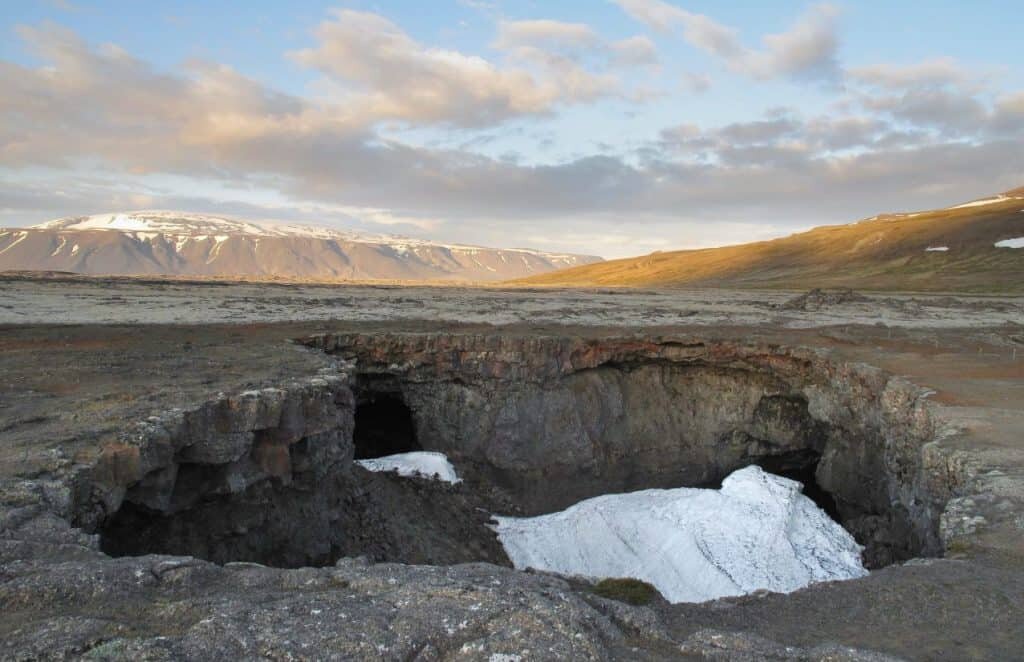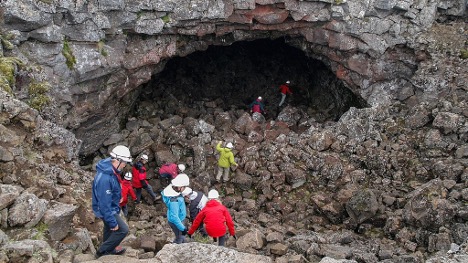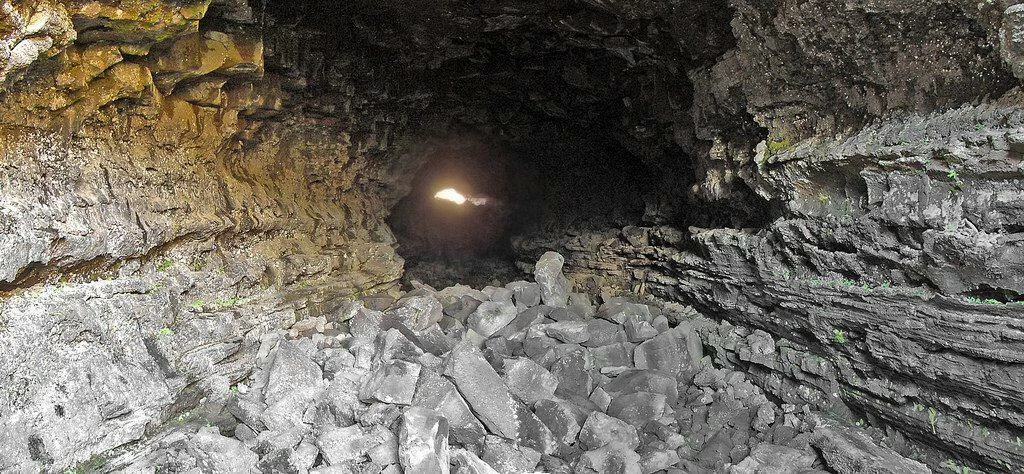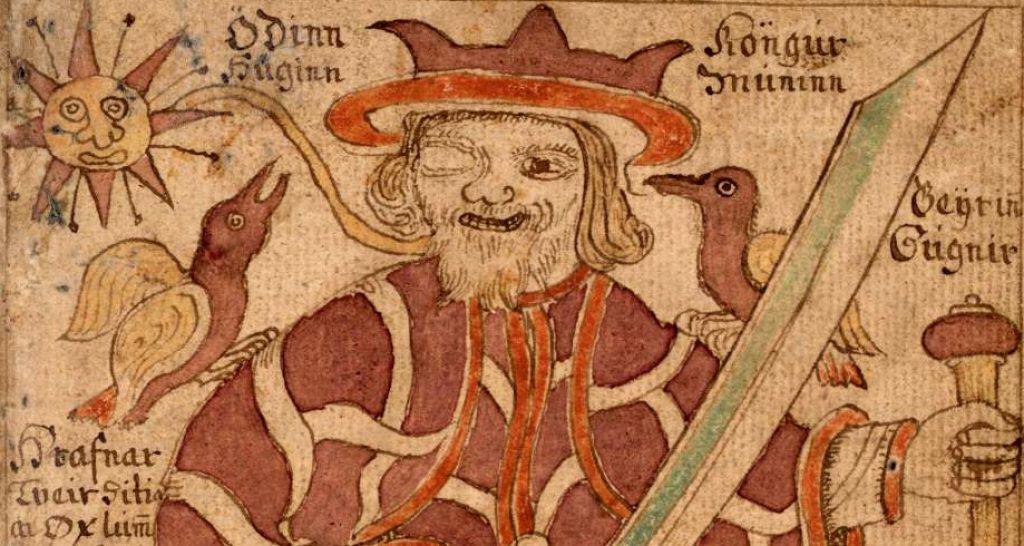Around 930 CE in the Land of Fire and Ice, not long after the first major settlement arrived, a large volcanic eruption ravaged 90 square miles of the Borgarfjörður region of Iceland’s western interior. What resulted was the Hallmundarhraun lava field and, below its basalt surface, twelve lava tube cave systems. One of those caves in particular, Surtshellir, has an intriguing history. It was named after the Norse fire giant, Surtr, meaning “black,” and is significant for several reasons. Surt’s Cave houses one of the most well-preserved Viking Age stone structures on the island. Additionally, mysteries of bandit occupation, human mutilation, and the propitiation of the fire giant surround the black cave.

The Surtshellir cave system is 2 miles long and includes the upflow segment of Stefánshellir. (Credit: Islandeek, CC 2.0)
Man-Made Structures in Surtshellir
Although there are many caves in Iceland that have evidence of temporary habitation, Surtshellir is unique. Radiocarbon dating of animal bones from within the cave indicates that different groups used the lava tube consistently for up to 1000 years. The cave was probably still warm at the time.
Researchers Kevin Smith from Brown University and Guðmundur Ólafsson of the National Museum of Iceland were the first scientists to conduct an archaeological survey of Surt’s Cave. In 2001 the team conducted an initial investigation. Then in 2012, they returned to gather a substantial amount of evidence. Their discoveries within the cave weave a most intricate picture filled with many possibilities.
Fortification Wall
The summer of their first official exploration in 2001 proved to be warmer than usual. This allowed for substantial ice melt-off that revealed hidden structures. About 300 feet into the cave, they discovered a large fortification wall that runs the width of the cave 30 feet across and 15 feet high. Previously, this wall was covered by snow drifts that blew in through the collapsed roof of the cave but subsequently became exposed in 2001. Originally, this area of the cave was shrouded in complete pitch-black darkness. The wall would have been formidable to build and, in the case of an intruder, difficult to scale in the dark.
“This would have been raised in the dark, well above people’s head height, totally sealing the cave. There’s not a doorway through it, there’s not a ladder way up through it … It’s the largest stone construction from the Viking Age in Iceland.”
According to Smith, Ólafsson, and McGovern in their 2009 paper, “Surtshellir: a fortified outlaw cave in West Iceland,” “The amount of labor and effort that had to go into the construction of this wall suggests that it is the work of many men and that it probably served as a fortification to stop intruders.”

One of four entrances to the Surtshellir lava tube in the Hallmundarhraun lava field. (CC BY-SA 4.0)
Enclosure
Farther back in the cave, there is a side gallery called Beinahellir or “Bone Cave.” This section once contained a large heap of bone fragments that were gone by the time of the archaeological survey. Unfortunately, tourists had been removing massive amounts of bones for many years from Surtshellir.
Past the bone cave lies perhaps one of the most well-preserved examples of a Viking Age structure. A stone enclosure runs across the cave. What it was exactly used for is a mystery: possibly a house (though the evidence is scant), temporary shelter, gatherings, or something more religious like a place of ritual and ceremony.
The enclosure is well-delineated with a short wall that curves around in the shape of a Viking-Age hall or boat. The structure measures about 20 feet long and 10-15 feet wide at the center, while the wall is 3 feet tall at its highest point. Taking up the entire width of the passageway, the enclosure blocks off the gallery that leads further into the deeper part of the cave, called Vigishellir. There is one opening in the front of the enclosure and one at the back facing into Vigishellir.1
Bone Heaps
Next to the enclosure is a midden pile containing animal bones that had been cut up, smashed, and reduced to tiny fragments. Whoever deposited the bones undoubtedly retrieved every last drop of bone marrow for sustenance. Although there may have been about 200 animals in this original bone heap, visitors to the cave pilfered a great deal of the midden.

Inside Surtshellir there is evidence of human activity dating back to the 10th century. Banco de Imágenes Geológicas, CC 2.0 Generic.
The researchers found a total of eight bone heaps around the cave.3 Testing indicated that they consisted only of domesticated farm animals: goats, cows, pigs, sheep, and horses. According to Smith, this is the only cave that had strictly domesticated animals in the bone middens. They did not contain any wild animal bones that would have been indicative of the hunting activity typical of early Icelanders. If people did actually live in the cave, the evidence suggests that they did not hunt for their food source.
Other Artifacts
In addition to the structures in Surtshellir, the team also found jasper fire starters, beads, and a set of lead weights in the middle of the enclosure that added up to 26 grams. One of the weights bore the shape of a cross. This may be the oldest Christian artifact in Iceland.3 According to Smith, the legal ounce in the old Scandinavian system was 26 grams until the 11th century. Ounce-units were used for various payments in legal transactions and as a fine if someone was guilty of breaking a law. This led the researchers to theorize that the pieces may have been used in some kind of legal proceedings. The reason why someone had placed the pieces in the cave is yet another mystery.
Outlaws in the Black Cave
The archaeological findings in the cave revealed definite human activity that probably began in the 10th century, but who those humans were is still uncertain. Although it is difficult to determine just how much truth legends provide, Icelandic tales of bandits and outlaws living in caves have been told for nearly a thousand years.
Mentions in Texts
The first mention of Surtshellir comes from the Icelandic Landnámabók or “Book of Settlements.” This manuscript details the settlers by name, their offspring, the names of their settlements/farms, and brief stories about the people, beginning in the late 9th century. The book attests to a group of eighteen outlaw “cave-dwellers” that were killed, although it does not specify the name of the cave. This story, however, does parallel legends about 18 outlaws who lived in Surtshellir and made their living raiding farmers’ livestock.
Additionally:
“In the fourteenth-century Harðarsaga, an outlaw is said to have fled from a fight with farmers near Hvalfjörður, to have taken refuge in Surtshellir with six other outlaws and then to have gathered more outlaws in the cave with him,” and in the Hellismanna saga, “Surthshellir is identified as the base of an outlaw band that fortified the cave in the late tenth century, preying on the surrounding countryside until routed by a coalition of local chieftains.”
Culture of Outlaws
There were many outlaws during the Commonwealth Period (930-1262) which was characteristic of a great deal of internal strife in Iceland. The various clans on the island were vying for power and control. Therefore, murders and injuries, such as mutilations, were culturally common.2
When someone broke the law, the typical punishment was a fine, outlawry, or exile. “Outlawry meant lifelong expulsion from the law. An outlaw lost all rights guaranteed by the law and his property was confiscated.”4 Sources such as Landnámabók mention multiple groups of outlaws that banded together and lived in caves.
Cult Rituals? Gods and Giants
One theory proposes that Surt’s Cave may have been a place of Pagan religious ritual. One example stems from the Landnámabók which said that a man by the name of Thorvald Hollow Throat traveled (about 90 miles) to Surt’s Cave specifically to recite a poem that he had written about the giant that dwelled within the cave.
This sheds some light on the religious beliefs of the Icelanders at that time. What we today call Norse mythology was once an entire system of religious beliefs that were not merely stories. The pantheon of powerful gods and beings were real for the Germanic people and included the Jotnar or giants, such as Surt. The Norse people feared, worshipped, and propitiated the powerful beings who often were the controllers of the forces of nature. According to Norse mythology, from the Jotnar the world was created. However, it is also the Jotnar who will destroy the gods and the worlds at the end of this cycle of time – also known as Ragnarok.
Significance of Surt
Surt, or Surtr in Old Norse, has a central role in Ragnarok. He is the fire-bearing giant who will come from the scorching southern region of the cosmos to lead the other Jotun in the burning destruction of the world. Freyr, the god of abundance and fertility, and Surt battle and eventually kill each other during Ragnarok.
The early Icelanders who witnessed the massive Hallmundarhraun lava flow as it demolished possibly six farms3 would have been very in tune with the connection between the frightening volcano and the fire giant. Logically, they would have desired to appease the spirit to prevent another eruption from taking place. Perhaps the poem that Thorvald recited to the giant was an offering and a prayer to keep Surt’s destructive forces at bay.
Pointing to Religious Activity: Firestarters and Beads
Besides Thorvald’s recitation of his poem to Surt, there may have been more intensive Pagan rituals in the cave. As briefly noted, the archaeological team found pieces of jasper fire starters under the thin layer of soil on the floor of the enclosure. There were red, yellow, white, beige, and green jasper from eight different areas of Iceland. However, the cave did not contain any of the black obsidian that was closest to Surtshellir.3 Colors played a significant role in ancient religious rituals. Were the users of the cave purposefully avoiding Surt’s color, black? And who brought the jasper from the faraway regions of Iceland? Kevin Smith alludes to an important point. Why would outlaws travel so far just to stay in this particular cave?
It is also curious that the second largest concentration of beads in Iceland came from Surt’s Cave. These were items of value. They took time, effort, and resources to make, and once they were crafted into a necklace or other adornment, they were probably worth some kind of exchange. Why would there be such an abundance of different types of beads scattered about the cave? Did they serve as some kind of protection or offering?
You May Also Like:
Yggdrasil Tree of Life and the Nine Worlds of Norse Mythology
Valhalla – Odin’s Hall of the Slain
High-Quality Domestic Animals
The type of meats and the time of year the animals died in slaughter may also indicate ritual activity. Analysis of the bones indicated that most of the slaughtering had taken place around late winter or early spring.3 The Germanic people commonly held community events and celebrations as a way to venerate the gods, spirits, and ancestors for various purposes. An important part of these events was the sacrifice of animals. Historically, various winter and spring festivals took place, and, additionally, “culling of the herds” was sometimes necessary when winter hay supplies began to run low. This provided an opportunity to sacrifice animals as offerings to the gods/giants and to have a community feast.
Horse meat had a particularly significant value for sacrifices, as did some of the other types of animals the archaeologists discovered in the bone middens. Healthy animals that had never engaged in hard labor also made for choice sacrifices. Interestingly, the analysis revealed that the slaughter of animals from the cave occurred in the prime of their lives.
Lack of Evidence
What the team did not find in the cave may be the most telling. They did not find many indicators of long-term cave habitation such as water collection sources, latrines, extensive use of fires, cooking tools, or bedding areas.
The Mutilation of Órækja Snorrason
In the Íslendinga Saga, presumably written in the 13th century by the historian and chieftain, Sturla Þórðarson, there is a story about two of the author’s first cousins. One of them was the illegitimate son of Snorri Sturluson (author of the Prose Edda), Órækja Snorrason, and the other was Sturla Sighvatsson. Sturla was also a chieftain. Órækja was a thug who may have had something to do with the death of a friend of Sturla. This part of the story is uncertain, but whatever the cause, Sturla Sighvatsson captured Órækja and took him to Surtshellir. Once they were inside the cave, Sturla ordered one of his men to cut out Órækja’s eye and one testicle.
The Symbolism of One Eye and Castration
This maiming event may have also had religious implications. Odin is the powerful chief of all the gods who sacrificed one of his eyes to the god-giant (he possesses traits of both giant and god), Mimir. By doing so, Mimir allowed Odin to drink from his well of divine wisdom. In the text Grimnismol of the Poetic Edda, Odin also refers to himself as Jalk, meaning “castrated” or “gelding.” One can only speculate about why Sturla chose Surt’s Cave as the site for this act or why he took out only one eye and one testicle.

Odin depicted with one eye in the 18th-century Icelandic manuscript, SÁM 66. (Public domain)
Logically, the removal of the testicle is an act of emasculation. This deformity would forever ruin Órækja’s manhood and his chance of becoming a high official. But could the maiming have been more symbolic than that? It may have had something to do with the belief that the powerful fire giant lived in the cave. Apparently, even though Christianity had been in Iceland for about 200 years, Sturla was still aware of the old beliefs.
Looking at the Whys
Today, Surtshellir leaves us with more questions than answers. Why did the Vikings build the huge wall? Was it to protect outlaws? Did it keep people from wandering into Pagan rituals after Christian lawmakers banned such rituals? Why the avoidance of the nearest source of black obsidian fire-starter? Why were there so many valuable beads from various countries? And why did the people bring only the choicest domestic animals’ bones into the cave? Did beads and animals serve as offerings to Freyr for protection or to Surt in order to pacify him?
In the old Norse religion, gods and the Jotnar (giants) controlled nature and inhabited the wilderness. Thus, it is not surprising that Surtshellir developed a reputation as a place of spirits, evil, and doom. For several hundred years, the locals completely avoided the cave out of fear. Whether outlaws used it as a hideout or chieftains used it to host major sacrificial celebrations, thanks to the work of Smith and Ólafsson, the magic and mystery of Surt’s Cave are coming to light.
Top image: The Surtshellir cave system is 2 miles long and includes the upflow segment of Stefánshellir. Source: Islandeek/CC 2.0)
By Kimberly Lin
References
1. Ólafsson, Gudmunder, Kevin P. Smith, and Thomas McGovern. “Surtshellir: a fortified outlaw cave in West Iceland.” 2009.
2. Lawing, Sean B. “Órækja at Surtshellir: Myth, Miracle, or Mistake?” 2014.
3. Smith, Kevin P. Lecture, “Of Monsters and Men: Literary, Mythic, and Archaeological Views of Surtshellir Cave, Iceland.” 2016. Sourced on Youtube.
4. Sigurðsson, Jón Viðar. Chieftains and Power in the Icelandic Commonwealth: (The Viking Collection Vol. 12). 1999.
5. Dennis, Andrew, Peter Foote, and Richard Perkins. “Laws of Early Iceland: The Codex Regius of Grágás, with Material from Other Manuscripts.” 1980.